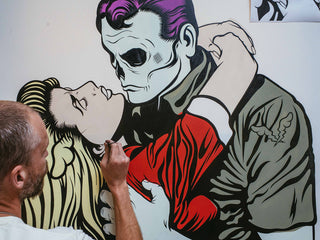It used to be that the po-po would nab you for paint-smudged fingertips. It’s broad daylight in Silver Lake, and D*Face is up on scaffolding, painting a towering woman with purple hair embracing an even taller zombie gentleman. When D*Face descends for the interview, and reaches out his hand to shake mine, I notice that I’ve caught him with his hands a felonious amethyst.
It’s different times now, though, from when D*Face—né Dean Stockton—kicked off his career in the late ‘90s, tagging his ubiquitous D*Dog around London in a time when the term “street art” was just a twinkling star of the future, and murals like the ones D*Face became famous for were most certainly done in the shroud of night. In the 20 years between then and now, D*Face has ridden the wave of street art from illicit spray paint on brick walls to canvases on gallery and museum walls, becoming one of the most celebrated street artists in the game.
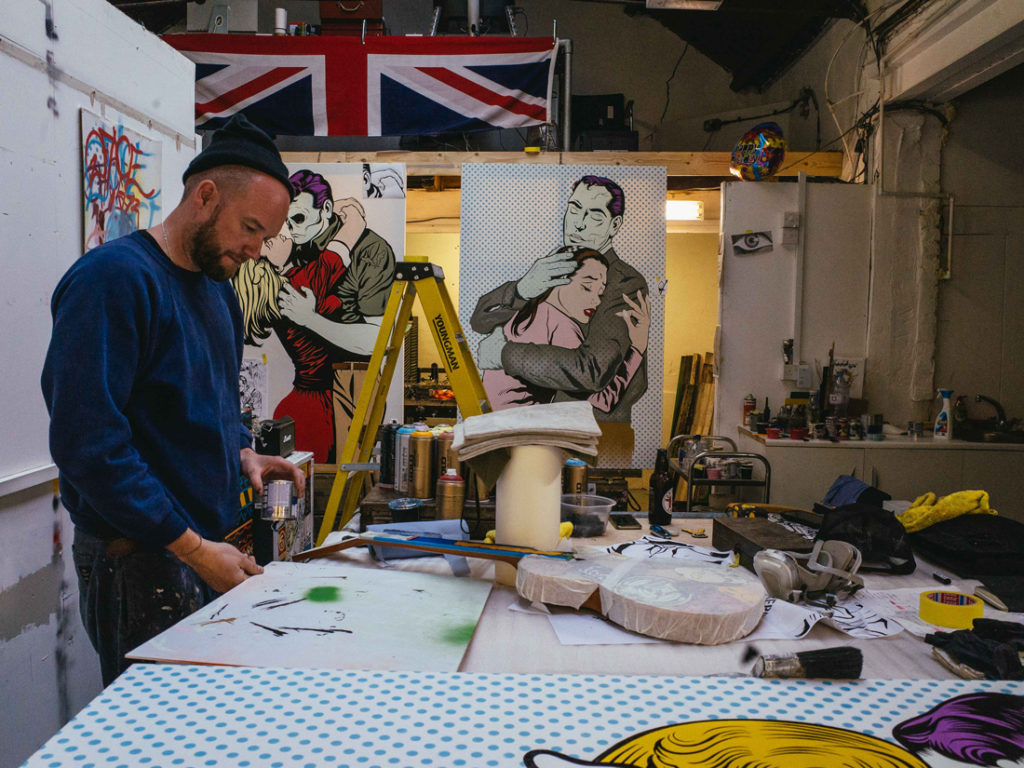
He’s done big things since those early days, from a portrait of Pope Benedict XVI commissioned by the Vatican to album covers for Christina Aguilera, and most recently, Blink-182. He’s shown in galleries all over the world, and continued to make his mark with commissioned murals in just about every major city.
His latest show, Happy Never After, opens at Corey Helford Gallery in Los Angeles this Saturday, September 23. It’s all about the type of love depicted by the zombie couple—undead lovers are an idée fixe for D*Face, showing up on murals in London, New York, Mexico City, and Miami. Those murals will be displayed on canvases, and there will be 22 original paintings, as well as a book series called “Read It and Weep.” But the kicker is that D*Face will be presiding over at least one wedding during the show’s opening.
With the mural looming over us, we chatted about the failings of modern love, how graf evolved into street art, and his long-overdue collab with The Hundreds.
MAXWELL WILLIAMS: Are you doing other murals around town?
D*FACE: After the gallery opening on the 23rd, we’re going to hopefully paint another wall. I try and do as much outdoor stuff as possible.
You’re not here all the time, but you have a lot of deep connections to L.A. Do you like to stay here as long as you can?
Basically. I’ve always wanted to be “California” since I was a kid. I have a connection to it that runs decades. So now when I get an opportunity to come here, it’s really weird, because now it’s like, “Oh, it’s L.A. I’m home from home.”
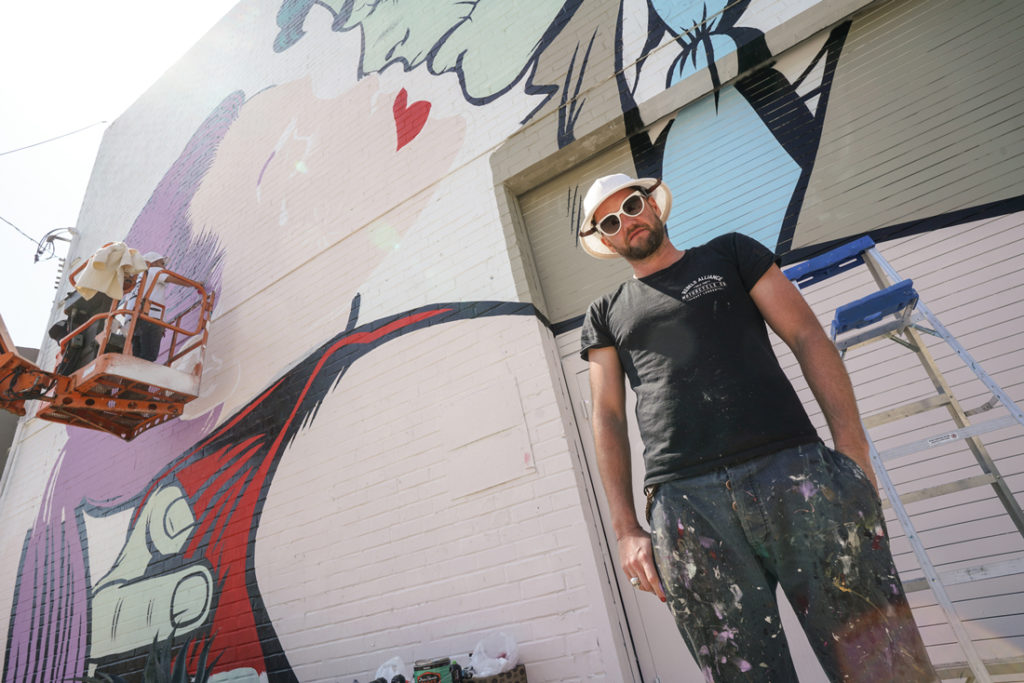
How many murals have you painted in L.A.?
Um, 1, 2, 3, 4, 5, 6, 7. 7 or 8. More in L.A. than I have in any other city in the world.
L.A. is open so open to murals—there’s street art murals, and the Chicano movement murals, and artist billboards.
Yeah, it’s a part of the visual scenery. For me, it’s part of the landscape. Unfortunately, you don’t get that in London. There isn’t the strong mural scene that is in other cities around the world. That’s why I come to L.A.; I come to paint.
Tell me about this mural. I can see how it connects to your show, Happy Never Ending. It’s very romantic with the woman in an embrace with a zombie character. Tell me a little about what’s going on in the mural.
I don’t want to give away too much, but the piece is called Parting Kiss. All of my work is about relationships and loved ones—and loss. That loss may be, not necessarily physical, but metaphorical. That person is no longer in your life. This piece, in particular, you’ll see that she has a slight tone of him in her. And the question is whether she’s sucking the life out of him or breathing life into him. That’s pretty much all you need to know about that.
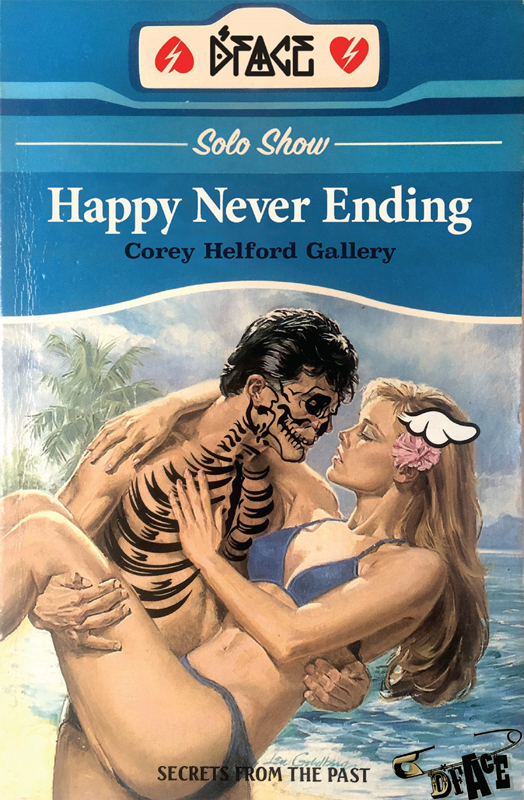
The flyer for D*Face’s solo show at Corey Helford Gallery, opening this Saturday September 23 through October 21.
So she’s either a bloodsucker or she’s giving him life. Like you said, a lot of your work is about romance. But this show is very specifically about romance. You’re even taking romance novel cover illustrations and painting over them. It’s optimistic, but carefully so, and nostalgic for, in your words, “the lost romance of a bygone era where even in death, the memory of a loved one could last an eternity, and marriage went beyond a symbolic gesture.” Does that mean you feel like modern romance is missing something?
It definitely is. I’m not on Tinder, but I have young friends, and I see how they meet and date people, and it feels like there’s a lack of art in being romantic. People are almost treating dating disposably, like it’s Ikea. It’s very easy now to connect, whereas when I was a kid, that wasn’t the way. You had to meet a girl at the right place, because you were both there; you had to romance her; you had to meet her parents. There was a whole checklist of things you had to do before you could even get anywhere.
Now it just seems like none of that matters. It’s just like, Bang, gone, dusted. And like I said, I’ve seen my friends acting that way. It’s intriguing, but also, I find it sad. So, the overall theme of the show is the death of romance. And the play on that is that the characters are predominantly “deathly” within it, but it’s more about the idea of romance being dead. It’s me being nostalgic, and trying to bring back that element of meeting someone.
Do you still believe in love?
Yeah, I totally believe in love. You can ask my friends: I’m very, very soft-hearted. I’m very open with my heart. I fall in love far too quickly and easily. And it leads me to be quite easily trampled on... I’m a hopeless romantic. I absolutely am. I believe in gestures. I believe in swooning someone, and sweeping them off their feet, and acting, and saying, and doing the right thing.
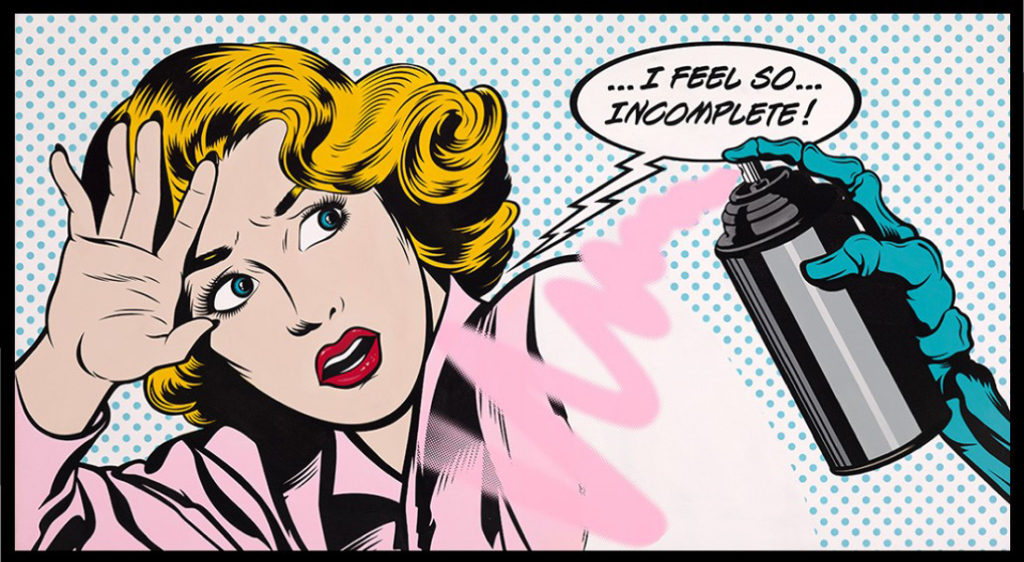
How does all this play out in the show?
I think the key for the show is I’m literally marrying somebody in the show. I’m ordained as a minister to be able to marry people. So, we’ve got two people getting married—we’re going to marry them on opening night. The idea is bringing the romance into the show directly.
And then there’s a graveyard?
Yeah, we’re making—hopefully—an installation, which will have the chapel in it, and around that will be some tombstones. The tombstones connect to the body of work the idea of romance, and happiness, and something ending. It’s going to be a little scene, hopefully.
Graffiti and street art started out as being transgressive. How do you still find a place to be a punk?
It’s interesting, because the course of graffiti and street art has changed. Graffiti is always going to remain pure and simple. It’s essentially about damage and getting your name up in whatever way—that’s, to me, pure graffiti.
Street art has gone from... when I was doing it originally 20 years ago, there was no term for it. It was an evolution from graffiti. [Street art] was a different manner and way of doing [graffiti]. And it was illegal. There was no such thing as “painting a mural”—there was no way to get permission. It used to have an impact by it’s nature. So, it was quite easy to be disruptive.
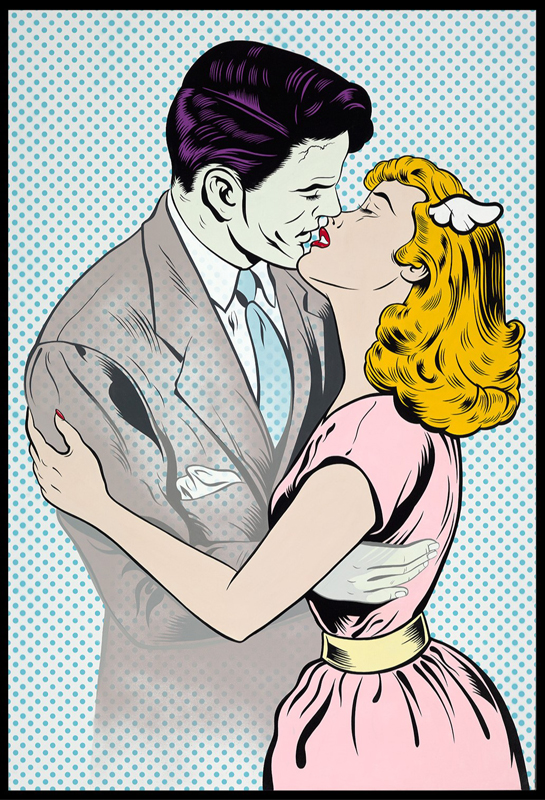
“Once Bitten” (enamel and pigment-based paint on medium grain cotton duck canvas 75 x 47″)
If you were doing it, you were being disruptive.
Yeah. By its very state, it was a political act. Because when you’re putting something illegal up, you’re questioning the idea of ownership and property. Now, obviously, everyone’s aware of what street art is, so you don’t have the same ability to have impact.
For me, moving into murals allows me to have a much bigger picture, and tell a much bigger story, and touch people in that way, rather than the individual small way.
People now are like, “Oh, it’s street art. It’s this guy—he’s quite well-known.” Everyone knows how to navigate street art now. And I think the only way out of that, for me, is to evolve with it. Evolve with gallery show work. Evolve what I’m doing in the public domain. And that would be from legal murals, but also dabbling in illegal stuff. Stuff that’s questionably illegal.
I make sculptures, and I install them illegally, and for me, that’s a nice transition from posters and stickers and tagging to something that you’ve actually invested a load of time into, and is essentially worth a load of money, and then you’re giving it to the public for free, and then you bypass all of the suits and ties that would have to be approached to have a sculpture approved in a public domain. So I still think you can be disruptive. I just think you have to think differently around it.
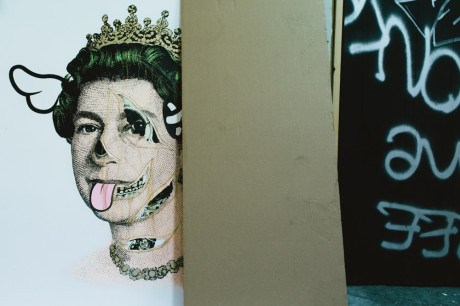
Photo: Suffoca.
A lot of your peers like Banksy and Shepard Fairey directly address what’s going on in the world, and take that stance that street art can be a powerful tool in the fight against things that are wrong—things like capitalism gone rampant. Do you find that it’s a necessary thing to address in the work?
I think it works for some artists. And I have done it, on occasion, when I feel it’s relevant to, but I think if you repeatedly do it, it loses its significance and relevance and its impact. When you see an artist who makes a political statement that doesn’t often make political statements, you pay attention to it. You’re suddenly like, “Oh wow, he obviously feels really strongly about that,” and it has a greater sweep. Whereas if you’re consistently making these political gestures, people are just like, it doesn’t mean anything.
Some people’s work works well for that visually. Some people have a much more political slant. For me, it’s the right time and the right place and the right message. And also, it’s hard enough in the world—it’s tough enough out there—it’s quite nice to not be ramming politics, and what bad is going on in the world, to everybody, and to just give them something that can be read into different ways.
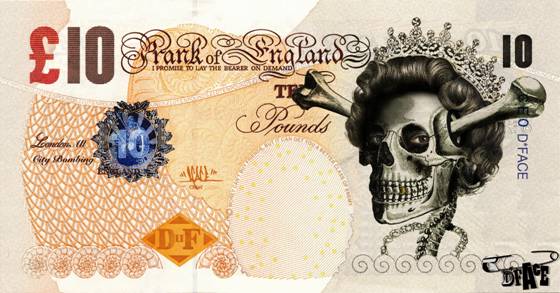
From D*Face’s early banknote series.
This new work could be read into politically.
Yeah. If you wanted to. Exactly.
You used to use a lot of imagery from other artists in your work—Warhol and Lichtenstein. I’m wondering what is your philosophy about the images that are in the world, and the access that you have to them, as an artist? And how you feel about using those images?
Mmm. Well, I used them more in the past, rather than in the present. I was trying to make a statement when I have referenced Pop Artists, because it’s more relevant when you’re referencing something directly to be like, “I’m turning that from that to this, because of this.” So when I’ve done that, I’ve tried to have a backstory that’s strong and a reason behind it.
For me, with Pop Art, it was always meant to be a critique of popular culture, and it became a celebration of popular culture. It was flawed. So with my work, I try to take that notion and that knowledge, and also know what’s happening in our society and the world, and try and bring that directly into it. It is a critique of our culture, but without it being quite so immediately obvious.
Now you’re doing it less and less. Is that intentional for you?
Yeah, I’m trying to develop what I’m doing based on what I have done previously. I’m trying to develop my style more and more. I’ve been doing it quite a while. I feel it’s more and more refined. I’ve done [references to other artists before], so I don’t feel like I need to go back over that ground. So I’m trying to push what I’m doing forward, and keep myself interested. Hopefully that keeps other people interested along the journey as well.
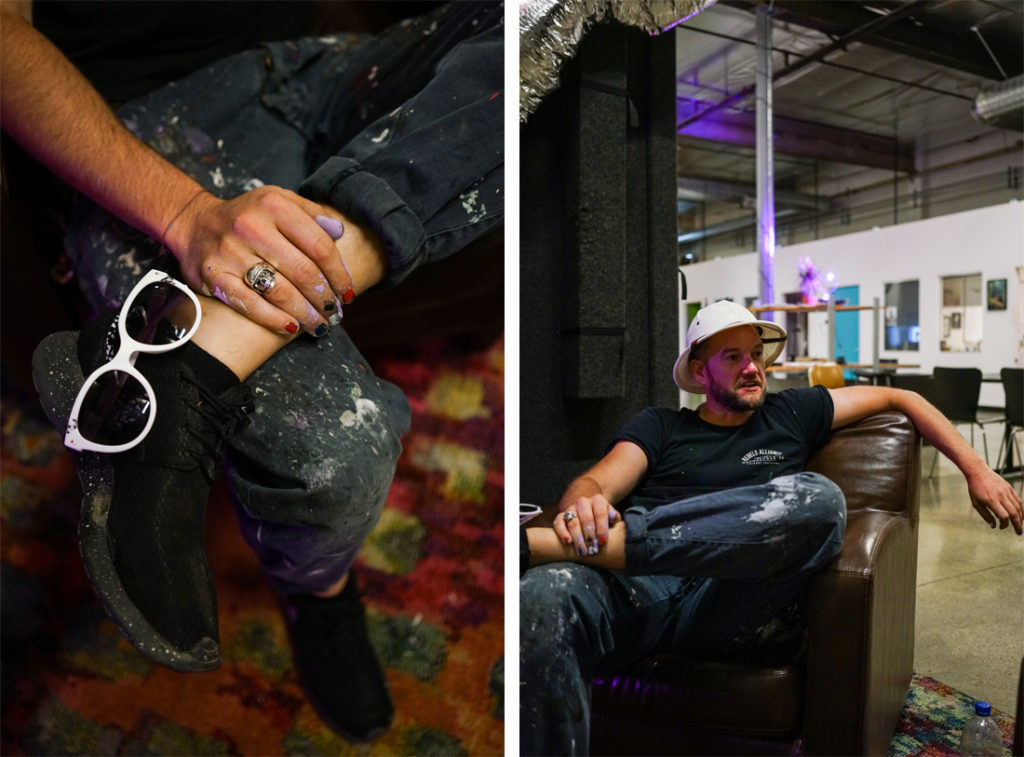
Because you’ve created enough original imagery that you can actually reference your own work now?
Exactly. Within my work, the characters have become like a family. So yeah I don’t need to go back and plunder the past. In regards to that, though, I think it’s visually interesting when people go and do that. When other people remix my work, I think it’s interesting. When a DJ puts a new song together using snippets of other songs, for me, that’s what I try and do with my work. Everything is out there in the public domain and it is so easily accessible these days.
Beyond the ideas of the way modern romance has developed, what other concerns about romance have you brought into this show?
The difficulties of it. Giving your heart up to somebody, and it not being reciprocated. Trying to navigate relationships. Maybe loving somebody more than they love you. Things like that that we all know and have experienced in trying to find that harmonious, perfect person that complements you. I think that’s what’s essentially in that body of work, too.

Talk a little about the collaboration with Hundreds.
I’ve always been a fan of the Hundreds. I’ve always seen Adam Bomb, and been like, “It’s made to have a pair of wings on it.” It’s so perfect for it. So obviously when that connection was made, I was like, “Of course. I know exactly what I’m going to do.” Take the two most iconic things that we both have, [Adam Bomb and D*Dog], and make a new thing from it. It has to be right for that character. Everyone’s like, “Oh, do the D*Dog.”’ I’ve moved away from that. When I bring it back, it’s because it’s got a real good reason to come back.
***
D*Face, one of the best-known street artists worldwide, is bringing his long awaited new solo exhibition “Happy Never Ending” to Los Angeles’s Corey Helford Gallery from Sept. 23 through Oct. 21.
The The Hundreds by D*Face limited edition T-shirt will be available opening night on September 23 and in the Online Shop September 25.

